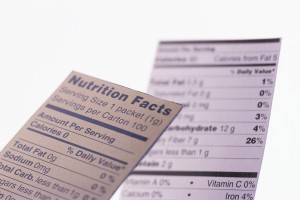In 2004, Congress passed the Food Allergen Labeling and Consumer Protection Act (FALCPA) to help with identification of FDA regulated foods that contain major food allergens. FALCPA has identified the 8 food allergens as: milk, eggs, fish, crustacean shellfish, tree nuts, peanuts, wheat and soybeans (and any ingredient that contains a protein derived from one or more of them). FALCPA applies to food products that are labeled on or after 1 January 2006. As a result of FALCPA, manufacturers are required to label food products that contain any of the 8 allergens by either including the name of the food source in parenthesis following the common name of the allergen, in the list of ingredients. For example:
Ingredients: Enriched flour (wheat flour, niacin, reduced iron, thiamin mononitrate, riboflavin, folic acid), sugar, partially hydrogenated soybean oil, and/or cottonseed oil, high fructose corn syrup, whey (milk), eggs, vanilla, natural and artificial flavoring) salt, leavening (sodium acid pyrophosphate, monocalcium phosphate), lecithin (soy), mono-and diglycerides (emulsifier)
Or, by adding the word “contains” followed by the name of food source from which the allergen is derived, either following or adjacent to the list of ingredients. For example: Contains Wheat, Milk, Egg, and Soy
Important to Note:
For more information on FDA/FALCPA:
Bottom Line: If WHEAT, or any of its derivatives, was used as an ingredient (& the product falls under FDA regulations), it should appear on the product ingredients’ label, but you still need to be a food detective when considering if barley (malt) or rye have been added (unless it is a product labeled “gluten-free” after Aug. 2, 2014, then you can assume it does not contain barley/rye or does in levels under 20 ppm) and when purchasing an imported product. Finally, unless a product has been “certified” gluten-free and processed on a dedicated gluten-free line, there is always a risk of cross-contamination. Many Celiacs can tolerate products that have been made in shared facilities, others cannot.
For that extra comfort level, to ensure a product is gluten-free, one can opt to purchase a product that has been certified gluten-free by:
Something to consider: Even products which are certified as gluten-free can be made in a facility that also processes gluten-containing items, but most facilities will take extra precautions when cleaning lines, and many manufacturers test their products for gluten content. Adding the statement about shared facilities is voluntary.
Australia: http://www.coeliac.org.au/crossed-grain-logo/
Canada: http://www.glutenfreecertification.ca/about-gfcp/
United Kingdom: https://www.coeliac.org.uk/food-industry-professionals/the-crossed-grain-symbol/